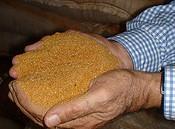As the second-largest export market for U.S. distiller’s dried grains with solubles (DDGS), Canada’s demand for the ethanol co-product continues to increase. Last year, Canada imported approximately 804,000 metric tons of U.S. DDGS. Industry experts anticipate more volumes to be traded in 2010. Much of this growth can be attributed to greater awareness about the product.
“The Canadian livestock producer has more information today on the chemistry, use and economics of DDGS,� said Ryan Slozka of Rycom Trading Ltd., a U.S. Grains Council member.
Three to four years ago, Canadian livestock producers were feeding a maximum of 10 percent DDGS in their rations before gradually moving to 15 percent and now 20 percent and 30 percent inclusion.
“15 percent and 20 percent inclusion is the average,� said Neil Campbell, USGC consultant in Canada, “but nutritionists are using results from trials and on-farm experiences to demonstrate that DDGS inclusion rates at higher levels will lower their feed costs.�
In addition to the lower feed costs, the price of DDGS is also attracting converts. Slozka predicts 2010 will bring more U.S. exports to Canada with the period of April-May-June being a key time frame.
“DDGS is currently trading at 105 percent of Canadian barley whereas in 2009 it was in excess of 120 percent and pulled out of the ration. It wasn’t until July that we saw DDGS values trading this close to barley,� he said.
While any growth is welcomed by the industry, Slozka does emphasize caution.
“It is important for the Council, its members and Canadian livestock producers to understand that rapid growth can come with a setback,� he said. “Increased demand invites more players into the market. Feedlots unfamiliar with DDGS may start with the product but discontinue it following a bad experience. More traders are entering the market and do very little in the way of product awareness and ensuring product quality. It is important that we all continue to further educate ourselves on the variability of DDGS, the logistical constraints and performance benefits in livestock rations.�
Slozka said Rycom Trading has responded to Canada’s growing demand for DDGS through the acquisition of a transloading facility, Rycom Transload Services, LLC, in Sunburst, Mont., seven miles south of Alberta, Canada. Situated along the Burlington Northern Santa Fe Railway, the facility gives producers access to more DDGS manufacturers while eliminating total reliance on the Canadian Pacific Railway.
Written by Jodi Kiely, USGC Contributing Writer


